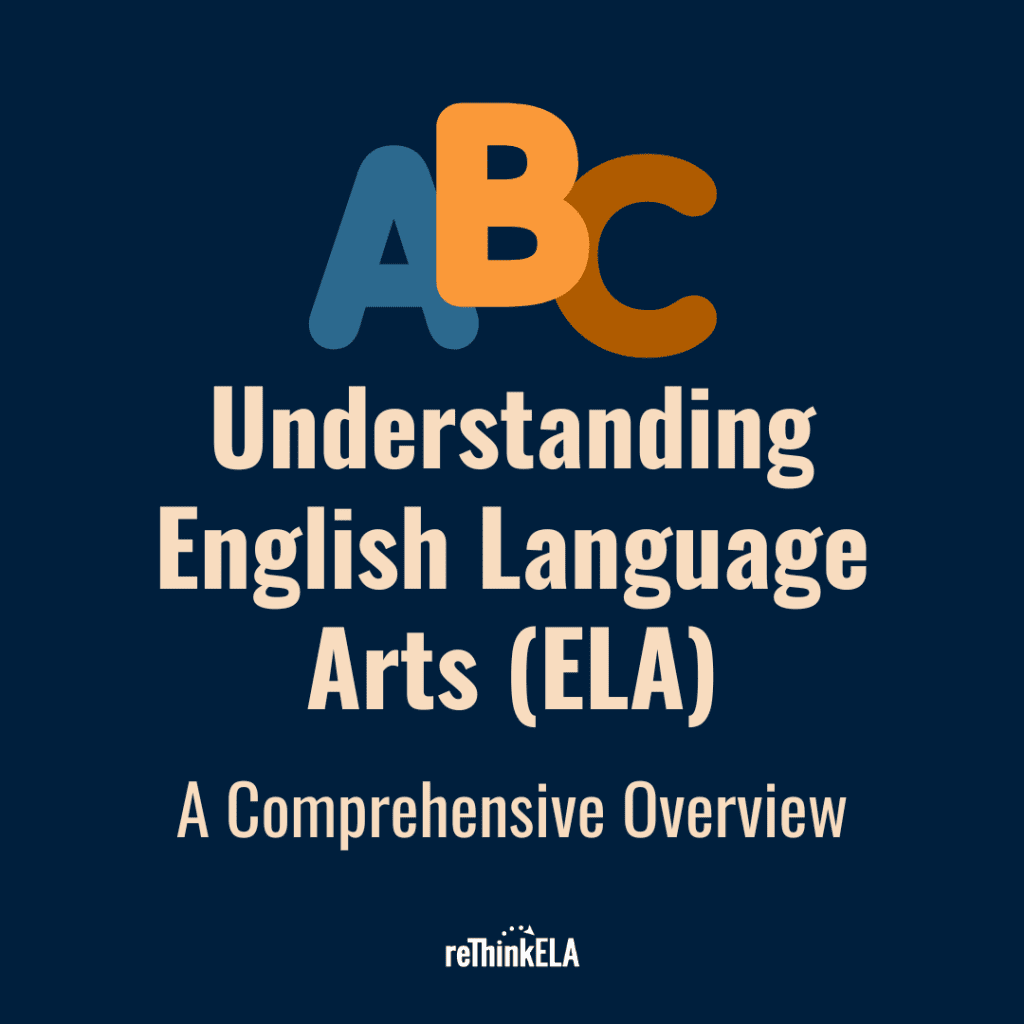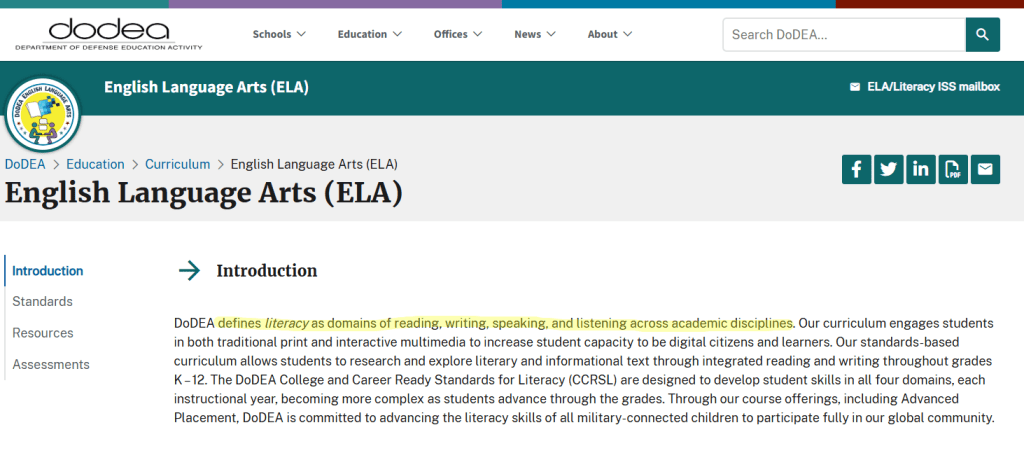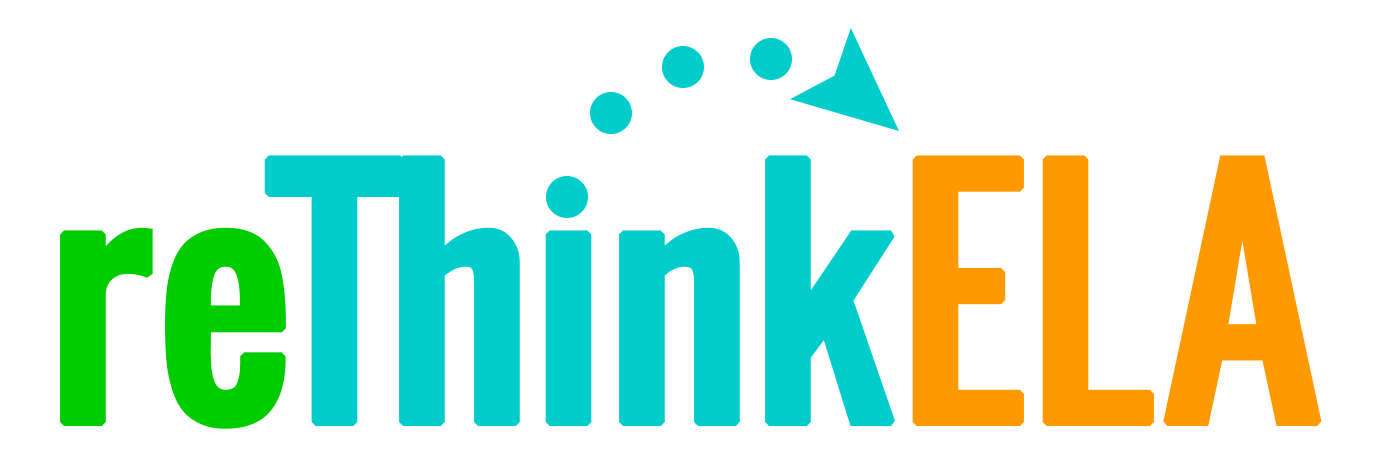
One would think, after spending 10 years teaching English language arts in secondary schools and 13 years writing about the topic, I would have defined the term somewhere. But “ELA” is one of those acronyms that represents a term everyone thinks they understand. But if there is anything that I’ve learned from my PhD program, it’s that defining my terms is the key to establishing a shared understanding and enhancing clarity and precision. Both of these reasons support avoiding misinterpretations.
So I googled an answer. The very first result comes from the Department of Defense Education Activity, an official website of the U.S. Department of Defense.

Click to Enlarge
While the DoDEA page acknowledges the components of ELA, it doesn’t really give a definition, so I clicked the breadcrumb for the curriculum page and found this:

Click to Enlarge
While this summary still focuses on the components of ELA, it comes a little closer to being a definition.
The next reputable website on the results page is the New York City Public Schools, which states “in English Language Arts (ELA) students learn to become effective readers and writers. Teachers use a balance of complex fiction and non-fiction texts in the classroom and teach reading, writing, vocabulary and discussion with an emphasis on using details and evidence from the text.”
Then, according to Dictionary.com, ELA is “a core course of instruction in an elementary or secondary school where students develop listening, speaking, reading, composition, grammar, and spelling skills in English.” The site also acknowledges another definition for the acronym that is not specific to reading and writing.
After pondering the results of my google search, I decided to turn to the organizations who helped me become the English teacher I am today. During my early years in the middle and high school classroom, I turned to professional organizations to help me learn how to be a better teacher. One of the first organizations was the Oklahoma Council of Teachers of English, an affiliate of the National Council of Teachers of English. This was the first organization that provided professional development I could use and helped me become a part of the ELA community. This is also where I met my graduate school advisor and many of the colleagues I've worked with over the years.
All that said, NCTE has published a list of ELA purposes that reflect their guiding visions for their NCTE/IRA Standards for English Language Arts:
- All students must have the opportunities and resources to develop the language skills they need to pursue life’s goals and to participate fully as informed, productive members of society.
- These standards assume that literacy growth begins before children enter school as they experience and experiment with literacy activities—reading and writing, and associating spoken words with their graphic representations.
- They encourage the development of curriculum and instruction that make productive use of the emerging literacy abilities that children bring to school.
- These standards provide ample room for the innovation and creativity essential to teaching and learning.
- They are not prescriptions for particular curriculum or instruction.
- These standards are interrelated and should be considered as a whole, not as distinct and separable.
I also spent several years working on Adolescence and Young Adulthood/English Language Arts certification through the National Board for Professional Teaching Standards, so I looked up their standards to see if they provide a definition — which they do:
The field of English language arts consists of the interrelated skills of reading, writing, listening, speaking, viewing, and producing. A text may be spoken, written, or constructed solely of images. There is power in all words, but the written word is forever. Through reading, people connect to eternity and to each other. Readers can transcend the limitations of the immediate; they can empathize with characters from remote time periods and distant countries. Readers can find safety when they are feeling vulnerable and community when they are feeling isolated. Furthermore, readers form powerful bonds with each other as they experience a text and construct meaning together.
Through writing, speaking, and producing visual texts, students can develop their ideas and command attention. They can become agents of social change. They can open doors to new opportunities for themselves and others. When language is used clearly and precisely, it can help to discern what is false and clarify what is true.
The English language arts promote an active stance in the world. Those who can use language to interrogate reality help to support the free exchange of ideas. They can articulate their ideals and advocate for the realization of those ideals. However, there is also a playful and aesthetic aspect to language. Through the study of English language arts, students learn to appreciate the nuances of language and to delight in the ways words can be used to enchant, to shock, to instruct, and even to mystify.
The English language arts provide skills for lifelong learning. Success in English language arts has a powerful effect on success in other classrooms, other disciplines, and nonacademic aspects of life.
My own state, Oklahoma, elucidated the “fundamental purposes” of ELA in their 2021 Oklahoma Academic Standards:
- The language arts classroom is a place that is inclusive of the identities that reflect the richness and diversity of the human experience.
- All learners are supported to become independent readers in a range of disciplines.
- All learners are supported to become independent writers for a variety of audiences and a range of purposes.
- A literate citizenry possesses the skills required to analyze, evaluate, act upon, and compose a wide range of communications.
Based on all of this information, it would seem that we could define ELA like this:
English Language Arts (ELA) is a core area of instruction focused on developing students' skills in reading, writing, speaking, listening, and language mechanics. It encompasses the analysis and comprehension of diverse texts, effective written and oral communication, and a strong understanding of grammar and language conventions. ELA aims to foster critical thinking, informed citizenship, and lifelong learning.
My experience with English Language Arts in Oklahoma public schools as a student was heavily focused on literature. In high school, we primarily read and analyzed classic literature and poetry, with only occasional essay writing. Middle school emphasized grammar through worksheets, which contrasted sharply with the practical application of language in my newspaper class, where we learned grammar in the context of our writing. Notably, in seventh and eighth grade, ELA and reading were taught as separate subjects, with reading instruction provided by a specialist. Later, as a middle school teacher, I observed the district where I taught separating ELA and reading after I left, with the reading class rebranded as 'literacy,' which veteran teachers said was to avoid hiring a dedicated reading specialist.
After exploring various perspectives on defining ELA, it's clear that this is a multifaceted discipline aimed at developing comprehensive communication skills. With this understanding in place, let's take a closer look at the core components that comprise this discipline. These components, including reading, writing, speaking, listening, and language skills, work in tandem to foster literacy and effective communication.
The Core Components of ELA
Reading
Reading in ELA involves engaging with a diverse array of texts, both literary and informational. Students analyze themes, structures, and contexts, fostering comprehension and interpretative skills. This exposure to various genres enhances vocabulary and cultural awareness.
Writing
Writing instruction focuses on developing clarity, coherence, and creativity. Students learn to express ideas effectively across multiple formats, such as essays, narratives, and research papers. Emphasis is placed on grammar, syntax, and organization to strengthen written communication.
Speaking and Listening
Effective oral communication and active listening are vital skills cultivated in ELA. Students participate in discussions, presentations, and debates, honing their ability to articulate thoughts and respond thoughtfully to others. These activities promote confidence and collaborative learning.
Language Skills
A thorough understanding of language mechanics, including grammar, punctuation, and spelling, is essential. ELA instruction ensures students can navigate the complexities of the English language, enabling precise and effective communication.
The Importance of ELA in Education
Elementary School
In the early years, ELA focuses on foundational literacy skills. Students learn phonics, basic grammar, and begin to engage with simple texts. The goal is to build a strong base for reading and writing proficiency.
Middle School
As students progress, ELA instruction explores more complex texts and writing assignments. This is often where students who previously loved reading lose interest. Critical analysis and interpretation become central, and students are encouraged to develop their unique writing styles and voices.
High School
At this stage, ELA emphasizes advanced literacy and communication skills. Students engage with classic and contemporary literature, conduct in-depth research, and produce sophisticated written and oral presentations. This preparation is vital for success in higher education and professional endeavors.
Standards and Guidelines in ELA
The Common Core State Standards, along with other state's standards, provide clear benchmarks for ELA instruction, outlining expectations for student achievement at each grade level. These standards ensure consistency and rigor in literacy education nationwide.
Visualizing the ELA Framework
To better understand the interconnected components of ELA, consider the following diagram:

Click to Enlarge
This diagram illustrates the multifaceted nature of ELA and how each component contributes to comprehensive language mastery.
In short, English Language Arts is an integral part of education, developing essential skills that underpin academic achievement and effective communication. By fostering proficiency in reading, writing, speaking, and listening, ELA prepares students to navigate the complexities of the modern world with confidence and competence.
